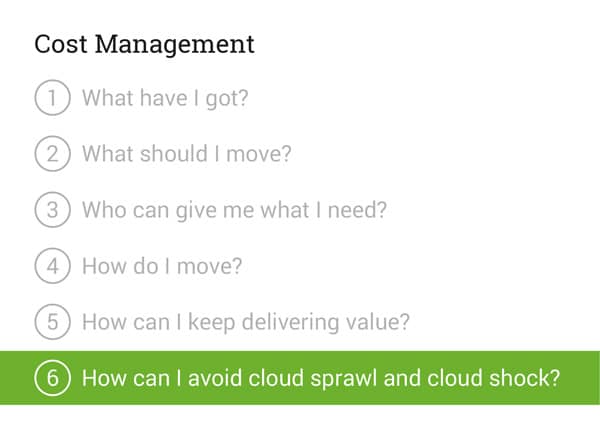How Can I Manage Cloud Sprawl and Cloud Shock?
-
March 7, 2019
- Posted by: Simon Croyden

As we saw in the previous post about continuing to deliver value, cloud migration is not a one-time project – there are still significant challenges to deal with after you’ve made the move. Above all, it’s important to keep the costs under control. Failure to do so has left many companies disappointed with their cloud moves – 57% of cloud budgets get exceeded, a third by more than 20%, according to the study1 by Softchoice we cited earlier in this series.

A major concern is how to manage “cloud sprawl”, where business units subscribe to, and implement, apps or services without the involvement of the IT function, or even its knowledge. This of course is none other than the traditional shadow IT challenge, but it can potentially escalate much faster than in a traditional environment because of the on-demand nature of cloud (which of course is a major reason for businesses to use it). Analysts have estimated that shadow IT already accounts for at least 50% of IT spend in large organizations, and that proportion is likely to be growing fast. No wonder 58% of IT decision-makers participating in a survey by Trustmarque2 said they were worried about spiraling cloud costs.
Unauthorized subscriptions to cloud apps and services incur significant costs, especially as they often remain in place after they are no longer needed, so that the costs continue to mount up. This cumulative growth can lead to “cloud shock” on the part of the CFO when invoices come in. Not only that, but unauthorized cloud use also brings security risks that could lead to reputational damage, regulatory fines, remediation costs, and other repercussions, both tangible and intangible.
For the business to manage cloud sprawl and avoid cloud shock, IT needs to stay on top of overall cloud usage. This is best done using automated tools that enable IT to view all cloud usage, including that initiated by business units without IT’s involvement. IT, business and finance then all need to collaborate to ensure that total spend is kept under control, and that money is only spent where there is a clear business benefit. Apps and services that are no longer used must be shut down in a timely manner. All this must be done without unduly constraining the business’s agility, which is perfectly possible provided new apps and services are adopted in a visible and controlled manner.
Once IT has a clear view of who is using which cloud applications and services and for what purpose, it can decide which to block and which to allow, and identify any conditions and restrictions that should govern their use.
While IT must implement mechanisms to manage cloud sprawl, it’s also important for senior management to introduce its own governance and monitoring framework for procurement of cloud services. It’s vital that senior business stakeholders and their IT counterparts are working in harmony on this issue.